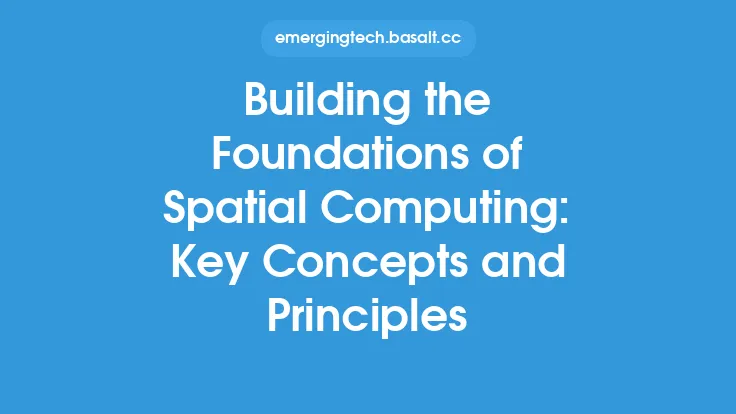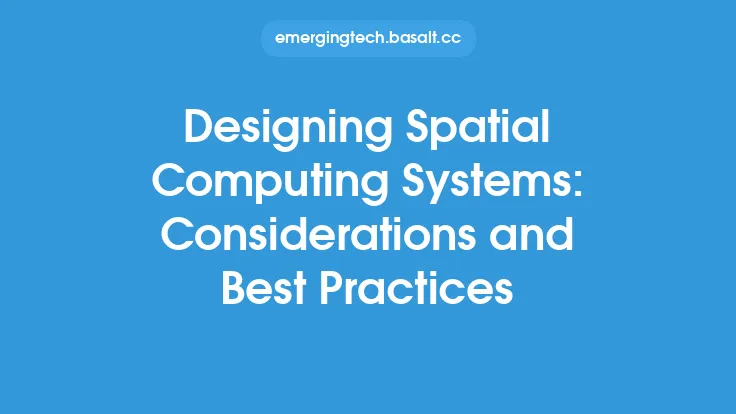The concept of spatial computing has been gaining significant attention in recent years, particularly in the context of human-computer interaction. Spatial computing refers to the use of spatial information and spatial reasoning to interact with computers and other digital devices. This technology has the potential to revolutionize the way we interact with machines, enabling more natural, intuitive, and immersive experiences.
Introduction to Spatial Computing
Spatial computing is a multidisciplinary field that combines concepts from computer science, geography, psychology, and design to create new ways of interacting with digital information. It involves the use of spatial data, such as 3D models, geographic information systems (GIS), and computer-aided design (CAD) software, to create interactive and immersive environments. Spatial computing can be applied to various domains, including virtual and augmented reality, robotics, and the Internet of Things (IoT).
Key Concepts in Spatial Computing
Several key concepts are essential to understanding spatial computing. These include spatial awareness, spatial reasoning, and spatial interaction. Spatial awareness refers to the ability of a computer system to understand its surroundings and the location of objects within that environment. Spatial reasoning involves the use of algorithms and data structures to analyze and understand spatial relationships between objects. Spatial interaction refers to the ways in which users interact with digital objects and environments, using techniques such as gesture recognition, voice commands, and haptic feedback.
Human-Computer Interaction in Spatial Computing
Human-computer interaction (HCI) is a critical aspect of spatial computing, as it enables users to interact with digital information in a more natural and intuitive way. Spatial computing uses various techniques, such as virtual and augmented reality, to create immersive environments that simulate real-world experiences. These environments can be used for a wide range of applications, including education, training, and entertainment. For example, virtual reality (VR) can be used to create interactive simulations of historical events, while augmented reality (AR) can be used to enhance real-world environments with digital information.
Spatial Computing Technologies
Several technologies are used in spatial computing, including virtual and augmented reality, 3D modeling, and geographic information systems (GIS). Virtual reality (VR) technology creates immersive, computer-generated environments that simulate real-world experiences. Augmented reality (AR) technology overlays digital information onto real-world environments, using techniques such as marker-based tracking and location-based services. 3D modeling software is used to create detailed, interactive models of objects and environments, while GIS software is used to analyze and understand spatial relationships between geographic features.
Applications of Spatial Computing
Spatial computing has a wide range of applications, including education, training, entertainment, and healthcare. In education, spatial computing can be used to create interactive, immersive simulations of complex concepts, such as anatomy and physics. In training, spatial computing can be used to simulate real-world environments, such as flight simulators and medical simulators. In entertainment, spatial computing can be used to create immersive, interactive games and experiences, such as VR games and AR experiences. In healthcare, spatial computing can be used to create interactive, 3D models of the human body, which can be used for diagnosis and treatment.
Challenges and Limitations of Spatial Computing
Despite its potential, spatial computing faces several challenges and limitations. These include the need for high-performance computing hardware, the complexity of spatial data, and the need for intuitive and natural user interfaces. High-performance computing hardware is required to process and render complex spatial data, such as 3D models and GIS data. The complexity of spatial data can make it difficult to analyze and understand, particularly for non-experts. The need for intuitive and natural user interfaces is critical, as spatial computing relies on user interaction to create immersive and interactive experiences.
Future Directions of Spatial Computing
The future of spatial computing is exciting and rapidly evolving. Several trends and technologies are likely to shape the future of spatial computing, including the increasing use of artificial intelligence (AI) and machine learning (ML) algorithms, the development of more advanced and intuitive user interfaces, and the integration of spatial computing with other technologies, such as the Internet of Things (IoT) and robotics. AI and ML algorithms can be used to analyze and understand complex spatial data, while more advanced and intuitive user interfaces can enable more natural and immersive interactions. The integration of spatial computing with other technologies can enable new applications and use cases, such as smart cities and autonomous vehicles.
Conclusion
Spatial computing is a rapidly evolving field that has the potential to revolutionize human-computer interaction. By using spatial information and spatial reasoning, spatial computing enables more natural, intuitive, and immersive experiences. While spatial computing faces several challenges and limitations, its potential applications and future directions make it an exciting and rapidly evolving field. As spatial computing continues to evolve, we can expect to see new and innovative applications, such as interactive and immersive simulations, smart cities, and autonomous vehicles.





